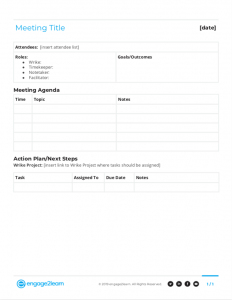5 Tips for Making Meetings Matter

The Meeting Madness
How often have you had a meeting on a topic only to realize you had already met on this topic previously and no decisions had been implemented yet? Employees are spending more time than ever in meetings; in fact, executives spend an average of 23 hours per week in them, according to contemporary research from the Harvard Business Review. In 2019 alone, meetings will cost U.S. companies a whopping $399 billion. Yes, BILLION! “Madness” truly is the only way to describe this!
But there is a solution, and like most of our e2L processes, it involves systems design. After all, meetings are essential to decision-making, problem-solving and productivity. When we use meeting protocols, we can increase our effectiveness. As the authors of Harvard’s “Stop the Meeting Madness” suggest: “Real improvement requires system change, because meetings affect how people collaborate and how they get their own work done.” So, here are a few tricks of the trade we employ at e2L! One of the most effective is having days where we have no meetings at all. We have two No Meeting Mondays per month to provide protected time for people to focus on tasks that take longer blocks of time without interruptions.
Creating a Meeting System that Optimizes Productivity & Performance
If people feel like their time is valued, they will become more focused, autonomous, and creative in meetings and, therefore, in their daily work. After realizing how much time our company was spending in meetings, we knew we had to be very intentional about creating a meeting system that truly valued people’s time.
In our company, we divide our meetings into three main categories:
- Scheduled learning and growth opportunities
- Standing meetings for organizational operations
- Project meetings for collaborative problem-solving and ideation/innovation.
By setting up a clear meeting structure, organizations can then put protocols in place for calendaring, attending, and creating action items. Without a clear meeting structure, communication and culture will suffer, or there will be numerous called meetings that are reactive to circumstances. This keeps an organization in crisis mode.
Based on the percentage of each meeting type and the amount of time you are investing in these meetings, you are determining-as an organization -what you are prioritizing and as an individual, what your role encompasses. For example, if 75% of your time consists of standing meetings for operations, you are in maintenance mode. Conversely, if 75% of your time is scheduled for project meetings, you are in continuous innovation mode. If you don’t schedule time for innovation, it won’t happen; but if you are in constant innovation mode, it is difficult to make forward progress.

5 Tips for Making Meetings Matter
Regardless of your meeting context, there are five tips that we have found helpful to ensure we have super-focused meetings where we accomplish our shared goals.
1. Always use an agenda.
An agenda with defined tasks and times is key to ensuring the meeting stays on track and that attendees know the purpose and focus of the time. Here is our agenda template for meetings. Our rule is that whoever called the meeting creates the agenda and links it to the calendar appointment in advance of the meeting. Also, a meeting should always start on time and end on time!
2. Begin with goals.
Start the meeting by determining the outcome(s) of the meeting together with the rest of the attendees. If it is a large group, you can prepare the outcomes in advance and get agreement from the team. Ensure the outcomes are tangible and check them at the end.
3. Establish roles.
Adopt a standard set of roles including a facilitator, one or more note-takers, a time-keeper, and someone who is responsible for assigning action items. There are other important roles, but you will not have an effective meeting without these in place. Rotating roles is one way to continue to grow people in the organization.
4. Check action items.
Leave at least 5 minutes at the end of the meeting to review the action items (AIs). You will find that when you do that invariably something was missed that is critical to be added. If you are not leaving the meeting with action items in place, why did you take the time to meet in the first place? You just wasted time talking to each other unless you assign AIs and everyone is clear on those next steps.
5. Use a task or project management system.
To ensure that the time is truly productive, it is not good enough for people to make a to-do list on the bottom of the agenda and call it good. Truly actionable meetings end with action items recorded in a task management or project management system with persons assigned and due dates set for each task. If it is a project meeting, the next meeting can begin with a review of the AIs assigned. Here are a few project management platforms to consider for your organization: Wrike, Asana, Scoro, BASECAMP, and Proofhub.
Converting all that wasted time into productive time that moves your mission forward is one of the keys to a culture of engagement and ownership within an organization. A culture of high performance is not an accident. People are motivated by protocols that honor who they are and what they can contribute. Imagine looking forward to meetings because you know something exciting and interesting is going to happen. We do!
How to Execute an Effective Meeting When Creating Your School District Strategic Plan
Strategic planning in education requires leadership, intention, active listening to feedback, and representatives from the schools, student body, and the community. Attendees of these strategic planning meetings come from diverse backgrounds, each will likely have their own self-interest and pre-formed opinions regarding the future direction of the public school in their district. To avoid conversations getting off-track, the following tips for conducting a strategic design process meeting are essential to implement.
The first step in hosting successful meetings is to establish clear and specific objectives. Identify the meeting’s aims, whether it’s curriculum development, academic improvement initiatives, staff training, or discussions about student performance. Clearly defined objectives not only determine the meeting's focus but also enable participants to come prepared with relevant ideas and data.
Identify Key Participants
Selecting the right participants is crucial for any meeting’s success. Determine who should attend based on their expertise, responsibilities, and contributions to the discussion. In strategic planning for schools, this may include teachers, administrators, support staff, and even students or parents, depending on the agenda. Having the right mix of participants ensures diverse perspectives and constructive dialogues.
Create and Share the Agenda
The agenda serves as a meeting roadmap, guiding participants through topics and allocated time. Share it well in advance, allowing participants to prepare and make necessary arrangements. Include specific discussion points, timeframes, and any pre-reading materials to enhance engagement and efficiency during the meeting.
Utilize Data and Analytics
Data-driven decision-making is a hallmark of education strategic planning. Gather relevant data and analytics to support the discussions and aid in making informed choices. This data may include student performance metrics, assessment results, feedback from previous programs, as well as any relevant market or industry trends. Integrating data into the strategic planning process enhances credibility and leads to more objective conclusions.
Encourage Participation and Collaboration
A successful meeting ensures all participants feel valued and engaged. Foster an environment that encourages open dialogue and constructive criticism. Encourage active participation from all attendees, as their insights can lead to breakthrough solutions and innovative ideas.
Utilize brainstorming sessions, breakout groups, and other interactive methods to promote collaboration and inclusivity. During the meeting, define roles, responsibilities, and timelines for each action item to ensure accountability and track progress.
These tips can help school district meetings drive positive change and make a lasting impact on the lives of students and educators alike. Well-structured and purposely planned meetings in school districts greatly benefit by fostering collaboration, innovation, and goal attainments.
Ready to Build Your School District’s Strategic Plan? Contact us to Get Started.




